In order to maintain a clean pool, it is recommended to drain it every 5-7 years. Warning signs such as cloudy water or excessive debris indicate that it is time for a drain. Additionally, high levels of chemicals and murky water are also indicators that drainage is necessary. To avoid any DIY mistakes, it is best to hire professionals for a safe draining process. After draining the pool, be sure to balance the pH levels and chemicals to keep the pool in pristine condition. Fiberglass pools require extra attention to prevent damage during drainage. If you are looking to be environmentally conscious, consider partial draining and regular chemical maintenance to lighten the load. Now that you have the basics, there is still more to learn for optimal pool care…
Key Takeaways
- Drain your pool every 5-7 years to prevent chemical buildup.
- Consider draining if TDS levels are high or water is cloudy.
- Regular drainage maintains proper chemical balance and water clarity.
- Drain if debris accumulates beyond regular cleaning capacity.
- Factors like pool condition and water quality influence drainage frequency.
Importance of Regular Pool Drainage
Ever wonder why it's essential to drain your swimming pool every 5 to 7 years? Well, let's delve into it! Regularly draining your pool is extremely important for keeping the water quality excellent and preventing nasty chemical buildup.
Imagine all those chemicals and impurities just hanging out in your pool water – not a pretty picture, right? By draining your pool regularly, you get to hit the reset button on your water quality and make sure the chemical balance is just right.
Neglecting this maintenance can lead to a whole host of issues down the line, like ineffective cleaning and yucky water quality. Nobody wants to swim in a pool that's not crystal clear!
Signs That Your Pool Needs Draining

Ever noticed your pool water looking a bit off? Signs it might need draining include high total dissolved solids (TDS) levels, cloudy water that won't clear up, and pesky algae growth that just won't quit.
When you can't seem to get the chemical balance right or debris keeps piling up no matter what you do, it might be time to say goodbye to that water and start fresh.
Water Level Concerns
If you notice difficulties in maintaining proper chemical balance in your swimming pool, it may be a sign that draining is necessary. When your pool water balances are off, it can throw everything out of whack, affecting water chemistry and the overall pressure of the pool.
High levels of total dissolved solids (TDS) can be a red flag, indicating the need for a good pool draining. If your water looks more like a mysterious murky swamp than a crystal-clear oasis, even after all your regular maintenance efforts, it might be time to contemplate draining.
Another clue that your pool is crying out for some drainage love is when you find it challenging to scoop out debris with your trusty skimmer net or vacuum. And hey, if you can't even see the bottom in the shallow end, it's definitely a sign that a draining session is long overdue.
Chemical Balance Issues
When encountering persistent challenges in maintaining proper chemical balance in your swimming pool, it may be a clear indication that draining is necessary.
If you find yourself constantly battling with balancing pool chemicals or if your pool water seems to be shrugging off the treatments you throw at it, it might be time to contemplate giving your pool a good draining.
High levels of total dissolved solids (TDS) can throw your pool water out of whack, making it stubborn and resistant to standard maintenance efforts.
Neglecting the signs that your pool needs draining can lead to ongoing struggles with chemical balance and ineffective pool maintenance.
By regularly draining your pool every 5-7 years, you can prevent the buildup of TDS and ascertain that your pool water remains in harmony.
Buildup of Debris
Excessive accumulation of debris in your pool, beyond what a skimmer or vacuum can easily handle, may signal the need for draining. When you start noticing that your pool maintenance routine is becoming a daily battle because of the sheer amount of debris floating around, it's a clear sign that a good draining is in order.
Imagine not being able to see the bottom of the shallowest end of your pool – that's a big red flag right there, indicating a significant accumulation of debris that needs to go. And hey, if your pool filter is working overtime 24/7 just to keep the water looking somewhat clear, it's probably because of that stubborn debris buildup that refuses to budge.
Sometimes, despite all your efforts to keep your pool clean, the debris wins the battle. That's when it's time to call in the pros for advice on whether draining is the best solution to bid farewell to that pesky debris once and for all.
Factors Affecting Drainage Frequency

Factors influencing how often you should drain your swimming pool include pool condition, maintenance practices, and water quality concerns. Keeping an eye on these factors can help you determine when it's time for a pool refresh.
If you start noticing your pool water looking a bit off, like it's not responding to your usual treatments or there's a funky chemical buildup, it might be a sign that draining is in order. Remember, it's essential to rebalance your pool chemicals correctly after draining and refilling to keep things safe and swimmable.
Also, be mindful of when you schedule your draining session. It's best to avoid doing it right after heavy rainfall to prevent any pool floating mishaps due to waterlogged grounds.
DIY Vs. Professional Pool Draining

Consider the potential risks and benefits before deciding between DIY pool draining and hiring professional services.
When it comes to DIY pool draining, there are some risks you should be aware of. Things like mechanical failures or even physical injuries can happen if not done correctly. If you're thinking about taking on the task yourself, make sure to check for issues like stripped drain screws beforehand.
On the flip side, professional pool draining services offer expertise and come equipped with the right tools to get the job done smoothly. They can also help minimize the risk of damage to your pool. If you've had past DIY draining failures, hiring professionals might be the more reliable choice for you.
Impact of Chemical Buildup on Draining

When facing the decision between DIY pool draining and hiring professionals, understanding the impact of chemical buildup on draining becomes essential. Chemical buildup in your pool can wreak havoc on your water quality and make it super stubborn to regular treatments. Here's why it's important to keep an eye on this:
- Resistant Water: Chemical saturation caused by debris, oils, and contaminants can make your pool water resist standard treatments, leading to a never-ending battle for cleanliness.
- Maintenance Issues: Ignoring the signs of chemical buildup can result in ineffective pool maintenance, creating a cycle of frustration and poor water quality.
- Balancing Act: Draining your pool helps reset the water quality by balancing out the pool chemicals and getting rid of all the nasty stuff that has accumulated over time.
Recommendations for Draining Fiberglass Pools

Draining fiberglass pools requires special attention due to the risk of causing structural damage if not handled correctly. Fiberglass pools rely on the water inside to support the panels and keep everything in place. So, before you even think about draining your fiberglass pool, make sure to chat with the professionals. Seriously, it's essential! These pools have their own set of rules and risks when it comes to draining, and going in blind could lead to some seriously pricey repairs. You don't want that headache, right?
Consulting with experts will give you the lowdown on the dos and don'ts of draining your fiberglass pool. They can guide you on the best approach to take, ensuring that your pool stays in great condition without risking any structural damage.
Maintaining Water Quality Post-Draining

So, you've drained your pool – great job! Now, let's talk about keeping that water sparkly clean.
Balancing pH levels, keeping up with chlorine, and watching alkalinity are your new BFFs for fighting off pesky algae and bacteria.
Water Chemistry Balance
Maintaining proper water chemistry balance post-draining is crucial for preserving water quality and preventing issues like algae growth. After you drain your pool, it's time to focus on keeping the water clean and safe for swimming. Here are some essential steps to maintain the right water chemistry balance:
- Regular testing: Make sure to test pH levels, chlorine, alkalinity, and calcium hardness frequently to confirm everything is in check post-draining.
- Chemical dosing: Based on your test results, adjust the chemicals in your pool to keep the water balanced and healthy.
- Monitoring CSI and CYA levels: Keep an eye on Calcium Saturation Index (CSI) and Cyanuric Acid (CYA) levels to prevent scaling and maintain water clarity after draining.
Algae Prevention Strategies
To effectively prevent algae growth and maintain water quality after draining your pool, implementing proactive strategies is key. Keeping your pool water chemistry balanced by regularly testing and adjusting chemical levels is essential in algae prevention. Make sure your filtration system is in excellent condition to effectively remove any potential algae spores from the water. Circulating the water adequately helps prevent stagnant areas where algae can thrive.
Establishing consistent maintenance routines, like skimming debris and scrubbing walls, is crucial to keep algae at bay in your newly drained pool.
In addition to routine maintenance, consider using algaecides and shock treatments as preventive measures. Algaecides can help inhibit algae growth, while shock treatments can eliminate any existing algae spores. By combining these strategies with proper water chemistry management, a well-functioning filtration system, and diligent maintenance routines, you can successfully prevent algae outbreaks and maintain crystal-clear water post-draining.
Eco-Friendly Pool Draining Practices

Consider implementing eco-conscious pool draining methods to reduce water wastage and minimize environmental impact during pool maintenance.
Here are some tips to help you drain the pool water in an eco-friendly manner:
- Partial Draining: Instead of completely emptying the pool, consider partially draining it. This method helps save water while still allowing you to clean and maintain the pool effectively.
- Submersible Pump Usage: Using a submersible pump can help you remove water from the pool without wasting excessive amounts. This efficient tool can aid in reducing water usage during the draining process.
- Proper Chemical Management: Maintaining the right balance of pool chemicals and regularly testing and treating the water can extend the time between full pool drains. By keeping your pool chemistry in check, you can promote sustainability and reduce the frequency of draining your pool.
Frequently Asked Questions
How Do I Know if My Pool Needs to Be Drained?
If your pool water looks like a mystery soup or there's a hidden treasure of debris at the bottom, it might be time to drain it.
Cloudy water that just won't clear up or algae that keeps coming back despite your best efforts could also be signals.
If your usual pool tricks aren't working anymore, it's time to contemplate a refill.
How Often Does a Swimming Pool Need to Be Drained?
So, how often should you drain that pool of yours? Well, think of it like a spa day for your pool – a nice little treat every 5 to 7 years.
But hey, if your pool is feeling a bit off, maybe needs a makeover, then it might be time to hit the reset button sooner.
Just keep an eye on those chemicals and water quality, and you'll know when it's time for a refresh!
Should You Drain Your Pool Every 5 Years?
Draining your pool every 5 years is a wise move to keep the water quality excellent. Regular draining helps prevent chemical buildup, algae growth, and equipment damage.
By sticking to this schedule, you'll guarantee your pool stays fresh and responsive to treatments. Just remember to avoid draining during heavy rain periods to prevent any floating pool mishaps.
After refilling, make sure to rebalance those pool chemicals for a safe and enjoyable swim!
Why Pools Should Not Be Drained?
So, you might be wondering why on earth pools shouldn't be drained, right?
Here's the scoop: draining a pool can mess with its structure big time. Think cracks, shifts, and all that not-so-fun stuff. Plus, you could end up with a pricey insect invasion or busted pipes. It's like a pool disaster waiting to happen!
That's why it's essential to keep up with maintenance and avoid the whole draining debacle.
Is the Frequency of Draining Public Swimming Pools the Same as a Private Swimming Pool?
The public swimming pool draining frequency is typically higher than a private swimming pool. Public pools have a higher volume of swimmers, which can lead to a quicker buildup of contaminants and bacteria. Regular maintenance and more frequent draining of the pool are necessary to ensure the safety and cleanliness of a public pool.
Conclusion
So, there you have it, folks! Remember, keeping your swimming pool in tip-top shape means draining it regularly.
Don't let the pool gunk take over – stay on top of it like a boss! Whether you DIY or call in the pros, just make sure to keep that water crystal clear.
Your pool will thank you, and your swimmers will love you for it. Happy swimming!









